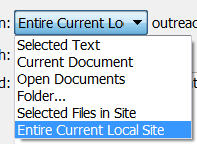A good rule of thumb in web design is to design with dial-up internet access in mind, by keeping your page load time as short as possible. This can be called the 25 second rule: that your page will load within 25 seconds on a 384kbs (kilobits per second) modem.
Dreamweaver has a page load time indicator in very small characters in the lower right corner of the document panel. It's easy to miss (see screenshot below). But it will tell you at any given time what your page load time is.
If you want to change the sped of the modem to see how fast your page will load under various conditions, go to the Edit menu, choose Preferences, choose Window Sizes. At the bottom of the dialogue box you will find a pulldown menu to change the speed of the modem (see below).



























